The Danish duo Fy og Bi (Fyrtårnet og Bivognen) was the most famous comedy couple of the European silent cinema. Long Carl Schenstrom (1881-1942) and short Harald Madsen (1890-1949) became very popular in the 1920s with their short slapstick films, known under such different names as Pat & Patachon, Long & Short or Watt & Half-Watt. Between 1921 and 1940, they made around 55 films.
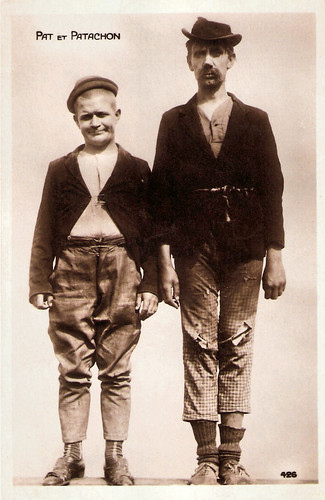
French postcard by Cinémagazine Edition, Paris, no. 426.
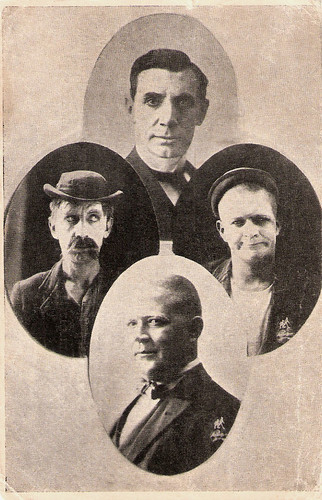
Russian postcard.
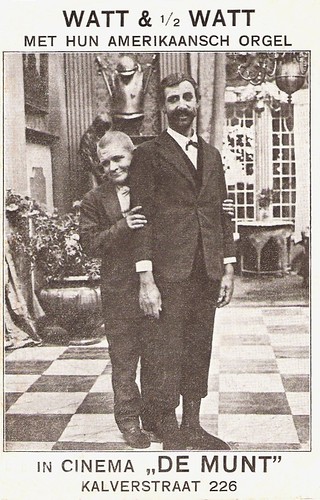
Dutch postcard. Fy og Bi were called Watt and Half Watt in the Netherlands. De Munt, Kalverstraat 226, Amsterdam, was the cinema for their films in Amsterdam.
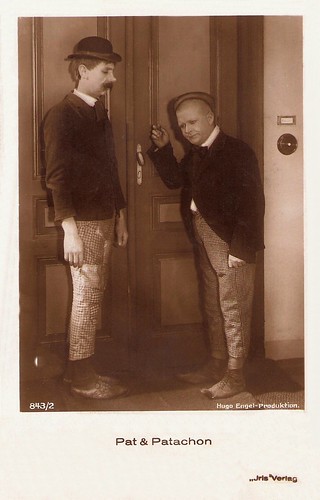
Austrian postcard by Iris Verlag, no. 843/2. Photo: Hugo Engel-Produktion.
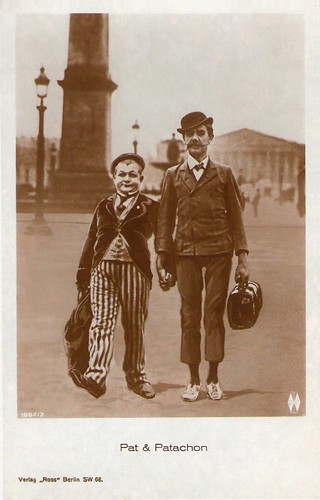
German postcard by Ross Verlag, no. 1053/3 1927-1928.
In Germany and Austria, Fy og Bi were known as Pat & Patachon, in the Netherlands as Watt & Halfwatt, in France as Doublepatte et Patachon, in Great Britain as Long & Short, in Sweden as Telegrafstopen och Tilhengern and in the US as Ole & Aksel.
Before Abbott & Costello, Martin & Lewis and Laurel & Hardy, Fy & Bi were the world's first internationally famous comedy team.
In contrast to Laurel & Hardy, they were not thick and thin, but long and short. Fy's full Danish name was Fyrtårnet (lighthouse) and Bi's full name was Bivognen (sidecar). Fy og Bi also did not appear in suits and bowlers but were vagabonds. They ran around in torn clothes or used an old rope as a belt.
In their films the duo interferes in the everyday life of bourgeois society, which they help to find new happiness in love or domestic chaos using grotesque methods. Their films were successful box office hits in Europe.
Between 1921 and 1940 they appeared in 55 films. Lau Lauritzen senior directed their first 30 silent films. Even before the separation from Lauritzen in 1932, Schenstrøm and Madsen made several sound films with other directors like Alf's Carpet (1929). Since then, they filmed almost exclusively out od Denmark, mostly in Germany.
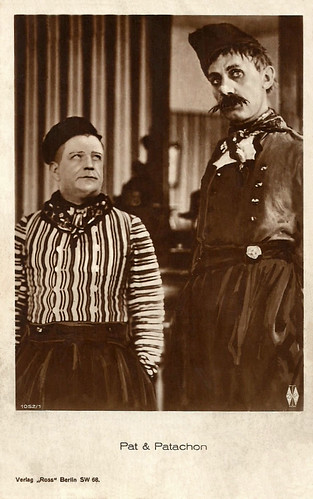
German postcard by Ross Verlag, no. 1052/1, 1927-1928.
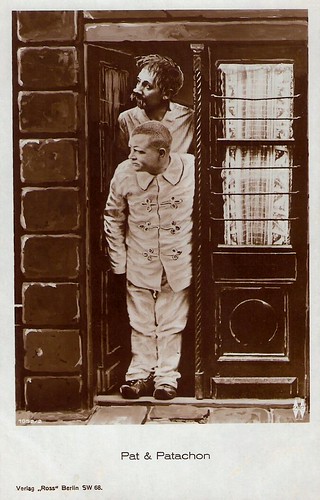
German postcard by Ross Verlag, no. 1052/2, 1927-1928.
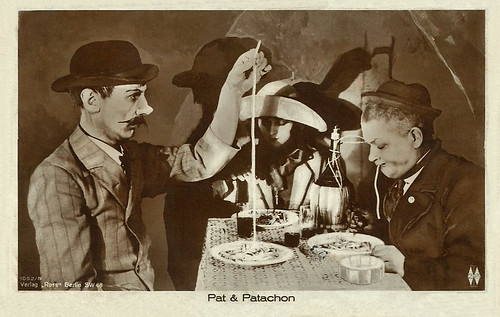
German postcard by Ross Verlag, no. 1052/5, 1927-1928.
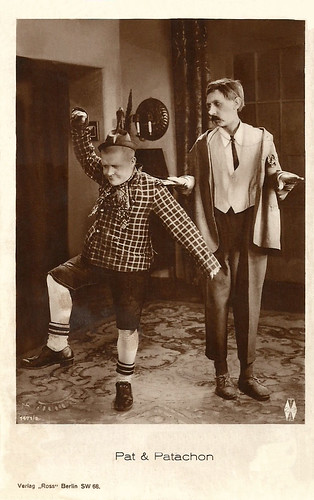
German postcard by Ross Verlag, no. 1471/1, 1927-1928.
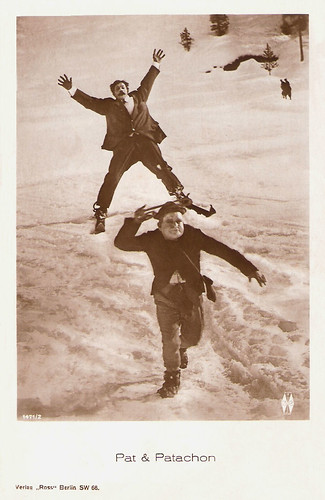
German postcard by Ross Verlag, no. 1471/2, 1927-1928.

German postcard by Ross Verlag, no. 1471/6, 1927-1928.
Carl Schenstrom (Fy) was born in Kopenhagen, Denmark, in 1881. He emigrated with his parents to America in 1890. Three years later they returned to Denmark.
Schenstrom finished a study as a bookbinder and started playing at theatres at the beginning of the 20th century. Because he did not earn enough money for his living he was looking for alternatives. In 1910 he joined the Nordisk Film Company in Denmark.
At Nordisk, he became acquainted with director Lau Lauritzen, with whom he moved over to Palladium in 1920. There he met Harald Madsen (Bi).
Madsen was born in Silkeborg on Ostjütland, Denmark in 1890. He already worked as an artist in a travelling circus since 1904. From 1915 he worked as a clown for different companies. He appeared in some films of the Svensk Filmindustri from 1917, in 1920 he changed to Palladium, where he worked as a comedian.
The following year, Schenbström and Harald Madsen (Bi) created Fyrtårnet og Bivognen in the short comedy Film, Flirt og forlovelse/The Film and the Flirt (Lau Lauritzen, 1921).
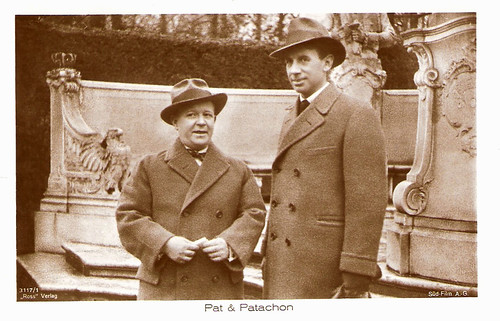
German postcard by Ross Verlag, no. 3117/1, 1928-1929. Photo: Süd-Film A.G.
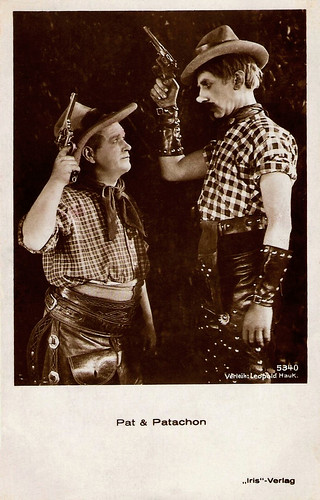
Austrian postcard by Iris Verlag, no. 5340. Photo: Verleih Leopold Hauk.
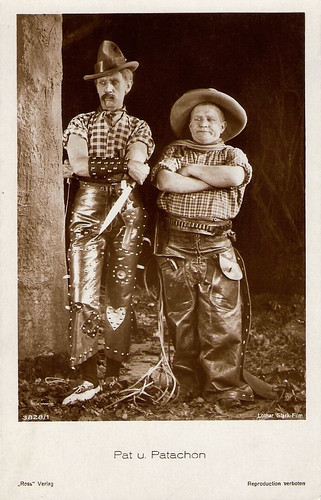
German postcard by Ross Verlag, no. 3828/1, 1928-1929. Photo: Lothar Stark-Film.
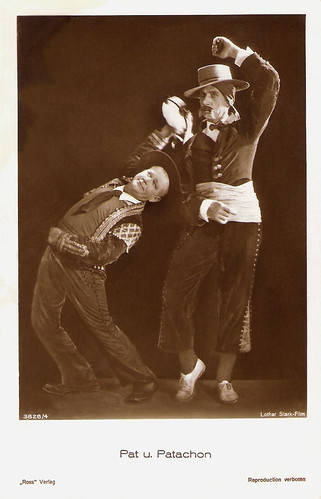
German postcard by Ross Verlag, no. 3828/4, 1928-1929. Photo: Lothar Stark-Film.
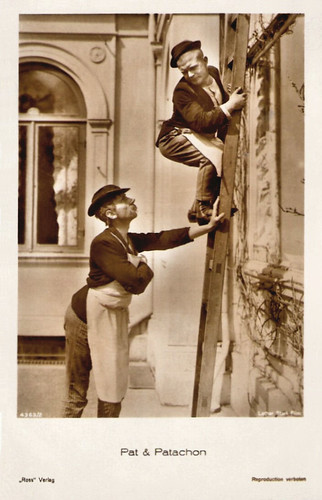
German Postcard by Ross Verlag, no. 4363/2, 1929-1930. Photo: Lothar Stark-Film.
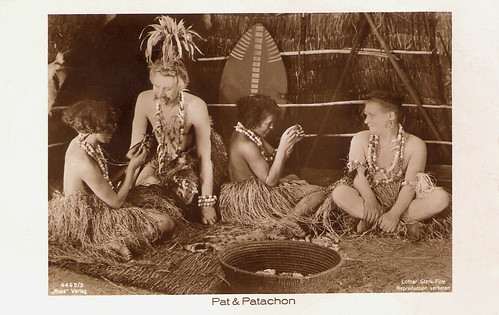
German postcard by Ross Verlag, no. 4463/3, 1929-1930. Photo: Lothar Stark Film. Still from Hallo! Afrika forude!/Hello! Africa ahead! (Lau Lauritzen, 1929).
After a series of 20-minute films in Denmark, Carl Schenstrom and Harald Madsen branched out into features produced throughout Europe.
Their first international performance was a small, very funny part as two drunken musicians in the German silent film classic Der letzte Mann/The Last Laugh (Friedrich Wilhelm Murnau, 1924) starring Emil Jannings.
By the late 1920s, their European popularity rivalled Charlie Chaplin's, being particular favourites of Soviet and German audiences.1000 Worte Deutsch/1000 German Words (Georg Jacoby, 1930) was their sound debut.
The outbreak of the Second World War brought their film activities to a near halt. Their last film as a team was the Danish I gode gamle dage/In the Good, Old Days (Johan Jacobsen, 1940).
Madsens’s health was affected by protracted illnesses. The circus he founded in later years went bust. He became afraid that the floodlight of the film studios would affect his health which made it difficult to shoot films with him. After Carl Schenstrom died in 1947, Harald Madsen tried to revive the legendary duo with a new partner, Carl Reinholdz, but he died the following year at the age of 59.
The famous scene from Der letzte Mann/The Last Laugh (1924). Source: Kinonik (YouTube).
Pat & Patachon in a scene from an unknown film. Source: Dermeister1A (YouTube).
Sources: Thomas Staedeli (Cyranos), Wikipedia and IMDb.
This post was last updated on 23 April 2024.

French postcard by Cinémagazine Edition, Paris, no. 426.

Russian postcard.

Dutch postcard. Fy og Bi were called Watt and Half Watt in the Netherlands. De Munt, Kalverstraat 226, Amsterdam, was the cinema for their films in Amsterdam.

Austrian postcard by Iris Verlag, no. 843/2. Photo: Hugo Engel-Produktion.

German postcard by Ross Verlag, no. 1053/3 1927-1928.
Vagabonds
In Germany and Austria, Fy og Bi were known as Pat & Patachon, in the Netherlands as Watt & Halfwatt, in France as Doublepatte et Patachon, in Great Britain as Long & Short, in Sweden as Telegrafstopen och Tilhengern and in the US as Ole & Aksel.
Before Abbott & Costello, Martin & Lewis and Laurel & Hardy, Fy & Bi were the world's first internationally famous comedy team.
In contrast to Laurel & Hardy, they were not thick and thin, but long and short. Fy's full Danish name was Fyrtårnet (lighthouse) and Bi's full name was Bivognen (sidecar). Fy og Bi also did not appear in suits and bowlers but were vagabonds. They ran around in torn clothes or used an old rope as a belt.
In their films the duo interferes in the everyday life of bourgeois society, which they help to find new happiness in love or domestic chaos using grotesque methods. Their films were successful box office hits in Europe.
Between 1921 and 1940 they appeared in 55 films. Lau Lauritzen senior directed their first 30 silent films. Even before the separation from Lauritzen in 1932, Schenstrøm and Madsen made several sound films with other directors like Alf's Carpet (1929). Since then, they filmed almost exclusively out od Denmark, mostly in Germany.

German postcard by Ross Verlag, no. 1052/1, 1927-1928.

German postcard by Ross Verlag, no. 1052/2, 1927-1928.

German postcard by Ross Verlag, no. 1052/5, 1927-1928.

German postcard by Ross Verlag, no. 1471/1, 1927-1928.

German postcard by Ross Verlag, no. 1471/2, 1927-1928.

German postcard by Ross Verlag, no. 1471/6, 1927-1928.
Circus
Carl Schenstrom (Fy) was born in Kopenhagen, Denmark, in 1881. He emigrated with his parents to America in 1890. Three years later they returned to Denmark.
Schenstrom finished a study as a bookbinder and started playing at theatres at the beginning of the 20th century. Because he did not earn enough money for his living he was looking for alternatives. In 1910 he joined the Nordisk Film Company in Denmark.
At Nordisk, he became acquainted with director Lau Lauritzen, with whom he moved over to Palladium in 1920. There he met Harald Madsen (Bi).
Madsen was born in Silkeborg on Ostjütland, Denmark in 1890. He already worked as an artist in a travelling circus since 1904. From 1915 he worked as a clown for different companies. He appeared in some films of the Svensk Filmindustri from 1917, in 1920 he changed to Palladium, where he worked as a comedian.
The following year, Schenbström and Harald Madsen (Bi) created Fyrtårnet og Bivognen in the short comedy Film, Flirt og forlovelse/The Film and the Flirt (Lau Lauritzen, 1921).

German postcard by Ross Verlag, no. 3117/1, 1928-1929. Photo: Süd-Film A.G.

Austrian postcard by Iris Verlag, no. 5340. Photo: Verleih Leopold Hauk.

German postcard by Ross Verlag, no. 3828/1, 1928-1929. Photo: Lothar Stark-Film.

German postcard by Ross Verlag, no. 3828/4, 1928-1929. Photo: Lothar Stark-Film.

German Postcard by Ross Verlag, no. 4363/2, 1929-1930. Photo: Lothar Stark-Film.

German postcard by Ross Verlag, no. 4463/3, 1929-1930. Photo: Lothar Stark Film. Still from Hallo! Afrika forude!/Hello! Africa ahead! (Lau Lauritzen, 1929).
The last laugh
After a series of 20-minute films in Denmark, Carl Schenstrom and Harald Madsen branched out into features produced throughout Europe.
Their first international performance was a small, very funny part as two drunken musicians in the German silent film classic Der letzte Mann/The Last Laugh (Friedrich Wilhelm Murnau, 1924) starring Emil Jannings.
By the late 1920s, their European popularity rivalled Charlie Chaplin's, being particular favourites of Soviet and German audiences.1000 Worte Deutsch/1000 German Words (Georg Jacoby, 1930) was their sound debut.
The outbreak of the Second World War brought their film activities to a near halt. Their last film as a team was the Danish I gode gamle dage/In the Good, Old Days (Johan Jacobsen, 1940).
Madsens’s health was affected by protracted illnesses. The circus he founded in later years went bust. He became afraid that the floodlight of the film studios would affect his health which made it difficult to shoot films with him. After Carl Schenstrom died in 1947, Harald Madsen tried to revive the legendary duo with a new partner, Carl Reinholdz, but he died the following year at the age of 59.
The famous scene from Der letzte Mann/The Last Laugh (1924). Source: Kinonik (YouTube).
Pat & Patachon in a scene from an unknown film. Source: Dermeister1A (YouTube).
Sources: Thomas Staedeli (Cyranos), Wikipedia and IMDb.
This post was last updated on 23 April 2024.
Wow! I did not know of this comedy duo! I love slapstick!
ReplyDeleteIt's a pity, that their films are never on TV here. The fragment from Der letzte Mann is so good. I love their postcards too. Thanks for stopping by, Cocamia.
ReplyDeleteToday, film historian and friend Egbert Barten mailed me (in Dutch):
ReplyDelete"zat weer eens op je postkaarten-site te kijken en kwam terecht bij de Deense jongens (volgens Bram Reijnhoudt in hun eigen tijd populairder dan L&H). Toevallig (maar wat is toeval) zat ik vanmiddag in een stukje eigen (nog ongepubliceerde) tekst te lezen waar ik tegen kwam dat die Watt en Half-watt films ook in de Hongerwinter in de niet meer
verwarmde Amserdamse bioscopen nog gedraaid werden. Leuk toch?"
My translation:
"Was back again watching on your postcards site and ended up at the Danish boys (according to Bram Reijnhoudt they were in their own time more popular than Laurel & Hardy). By chance (but what's chance?) I read this afternoon in an old (yet unpublished) text of my own and found that during the last famine winter of WW II, the Watt & Half Watt (or Ole & Aksel as they were known in the USA) films were still running in the not heated Amsterdam cinemas. Nice, right?"
So, they helped hungry Dutch people during the winter by keeping them laughing. Nice? They were heroes! We demand a Watt & Half Watt series on Dutch TV :) Thanks, Egbert for your information.
Wonderful stuff. I think the train going by in the archery scene was a matte shot. Very funny and clever. I'd never heard of these guys before. Thanks Bob
ReplyDeletemy favorite duo of all time, and yes im from denmark & i adore them so much of all my heart for they films, career, sweetness, humor and kindness. i admire the real actors behind the characters too
ReplyDelete